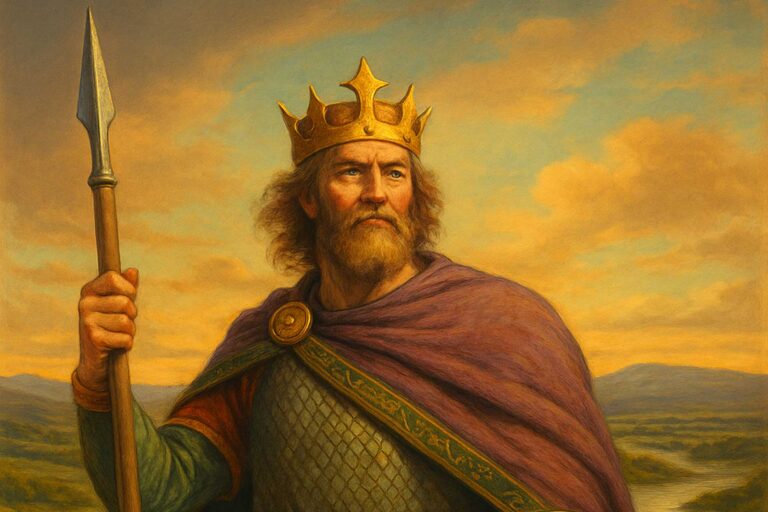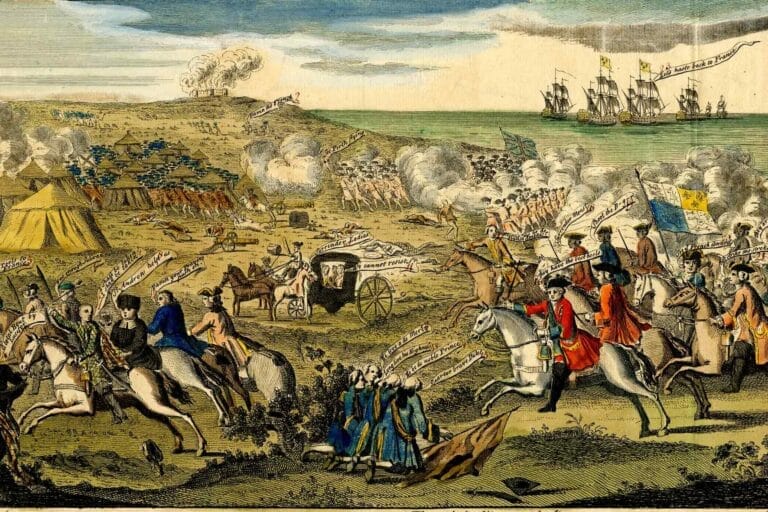Halfdan Ragnarsson: The Strategic Son of Ragnar Lothbrok
Ragnar Lothbrok was a renowned Viking sea king and Norse hero. According to myth, he was the scourge of the European countryside, conducting raids in the service of the great Danish king and siring a fierce cadre of warrior sons. Ragnar and his legend loom over early medieval history, and his offspring continued his work of conquest and subjugation across Europe. Many, like Ivar the Boneless, became known for their savagery and wild brutality. Halfdan Ragnarsson’s legacy stands in stark contrast to this reputation, characterized by pragmatism and relative strategic restraint.
Halfdan was a leader of the Great Heathen Army and a key figure in the Viking conquest of Anglo-Saxon England. Chronicles, such as the Anglo-Saxon Chronicle, attribute multiple campaigns to Halfdan, which resulted in Norse dominance of Northumbria and other territories. While his peers might have favored complete annihilation of their enemies, Halfdan’s approach combined martial prowess with a long-term view that often favored settlement and political control over the territories he and his forces claimed.

Early Life and Lineage
Halfdan Ragnarsson is generally considered to have been one of the many sons of the legendary Viking chieftain Ragnar Lothbrok, whose exploits are well documented by Norse sagas and medieval sources. Although the historical accuracy of Ragnar Lothbrok’s existence is debated, it is suggested that Ragnar’s sons, including Halfdan Ragnarsson, Ivar the Boneless, Bjorn Ironside, and Sigurd Snake-in-the-Eye, and Ubba, were the leaders of a Viking army known as the Great Heathen Army. The Anglo-Saxon Chronicle is a major source for Ragnar’s sons. It records an invasion of East Anglia in 865, mentioning Halfdan as one of several commanders, many of whom were probably his brothers.
Due to the scarcity of sources, it is not known when and where Halfdan was born, but he likely became a warrior during his adolescence. As the son of a noble Viking warrior, he would have been trained in battle and other aspects of warrior culture, including weapon skills, ship navigation, raiding and warfare techniques, as well as tactics and leadership abilities. This training and preparation is considered to have been responsible for making him one of the best Viking army commanders in history. Halfdan’s path to becoming a Viking leader would have been similar to that of other Viking sons. However, he was probably able to command larger numbers due to his apparent success as a commander.
Role in the Great Heathen Army
In 865 AD, Halfdan Ragnarsson became one of the leaders of the Great Heathen Army, the most famous of the many Viking warbands to invade England during the Viking Age. Halfdan and his brothers Ivar the Boneless and Ubba divided the rule of this large force, and were joined by many other sons of Ragnar Lothbrok. The army arrived in East Anglia in 865 AD, and set out to conquer Anglo-Saxon England. The Anglo-Saxon Chronicle details their arrival, as well as a sequence of campaigns against the kingdoms of Northumbria, Mercia and East Anglia. Halfdan Ragnarsson transitioned from an opportunist raider to an organized, tactical force.
The first target was York, the most important city in Northumbria. In 866 AD, the city fell to the Vikings and Halfdan helped to organize the conquest of a Northumbria torn by civil war. In the aftermath, the Viking army captured the local king Aella, the man held responsible for Ragnar Lothbrok’s death. As an act of vengeance, the king was put to death, likely by means of the ritualized blood eagle. The reality of this event is still debated, but it became an iconic part of Viking history, as Halfdan and his brothers exacted retribution.
Northumbria had fallen by the following year, and Halfdan went on to lead several successful campaigns, as the Great Heathen Army advanced into Anglo-Saxon England. Halfdan and his forces took tribute from Mercia, and then began to make war on the kingdom of East Anglia, capturing and killing their king Edmund. The combination of brutality and shock was destabilizing for the region, and a message to other Anglo-Saxon rulers. Halfdan’s ability to keep a large, fractious collection of Viking leaders unified and his military logistical acumen meant that the Great Heathen Army was able to remain in England for years, without major disruption.
In military leadership, Halfdan Ragnarsson is noted for his discipline and structure. He was not a berserker, in contrast to his brother Ubba,, and was more comfortable with long-term occupation and settlement than Ivar the Boneless, who favored psychological warfare. This influence would become important in setting the Viking military presence in England to a more organized, permanent state. Halfdan’s contributions to the campaigns were highlighted by victories, and the military foresight to establish Viking power in England as an organized force, rather than simple raiders, making him one of the most strategically successful Viking commanders of the 9th century.
Military Campaigns and Conquests
Halfdan Ragnarsson’s campaign in England took a strategic turn after the pivotal capture of York in 866 AD. With Northumbria firmly under Norse control, his sights shifted towards Mercia, one of the most powerful Anglo-Saxon kingdoms of the time. Halfdan’s military prowess had brought him this far, but his ambitions in Mercia were underpinned by a more calculated approach, one that focused on conquest and long-term gain.
Halfdan was known for his preference for full-scale assaults over hit-and-run raids when engaging with larger targets. The goal was not just immediate plunder but to weaken local rulers and extract tribute. Viking forces, under Halfdan’s leadership, would force their way into towns, overpowering local resistance. This often resulted in the installation of puppet rulers or leaders favorable to Viking interests, a long-term advantage that the divided Anglo-Saxon forces were hard-pressed to counter.
In addition to being a skilled warrior, Halfdan also demonstrated an interest in land and governance. He didn’t merely conquer and retreat as many Vikings of the era did. Instead, his campaigns were methodical, aiming not just for victory but for the integration of new regions into a nascent Norse-ruled territory. This would lay the groundwork for what became known as the Danelaw, with parts of northern and eastern England falling under Viking rule and governance.
Halfdan’s ambitions weren’t confined to Northumbria or Mercia. His campaigns also extended into East Anglia, where Viking dominance was further solidified after the death of King Edmund. Norse control of England now spanned much of the north and central regions, with Halfdan at the forefront of this expansion.
Halfdan’s career as a Viking leader thus stands out for its focus on strategic conquest and the establishment of rule in new territories. He was not just a warrior at the head of a raiding party but a leader with a vision for what a Viking England could look like. This approach, while not always swift or spectacular as more hit-and-run raids, proved effective in establishing and maintaining Norse power in significant portions of England.
Halfdan Ragnarsson is often remembered for his ability to balance sheer military might with political acumen. While he was undoubtedly a formidable warrior, it was his strategic mind that truly set him apart. His calculated conquests would come to define the shape of Viking England for years to come and provide a model for future Norse leaders who sought to settle rather than raid. In this way, his legacy endures not just as the son of Ragnar Lothbrok but as one of the most strategic Viking commanders in history.

The Founding of Danelaw and Settlement of Northumbria
In the following years, he decided to lead his Norsemen to settle down in the territories they won, for he “shared out the land of the Northumbrians and they ploughed and supported themselves.” As early as 876 AD, Halfdan shifted tactics by dividing the land he gained in Northumbria amongst his troops, setting a precedent for future Viking settlement in the region. This was a turning point in the Viking Age, signaling the transition from raiding to settlement, and it heralded the establishment of the Danelaw.
The entry for 876 in the Anglo-Saxon Chronicle suggests a considerable Norse occupation of the area: “Halfdan divided the land of the Northumbrians and they ploughed and took their living from it, and there they settled for that winter. And many companies of the Norsemen did not return home after this.” The Danelaw area extended to cover a large swath of England, wherein the laws and customs of the Norsemen were paramount, and English influence in these regions receded. The Norsemen who remained began to intermingle and settle in communities, shaping the sociopolitical landscape for years to come.
Halfdan Ragnarsson went from being a feared Viking raider to a ruler who put down roots in England. He understood that to truly hold power and influence, one had to build infrastructure and alliances. Settling in England, Halfdan and his men worked to create a stable and lasting presence. The act of dividing land and encouraging his people to farm and settle rather than returning to Scandinavia was a significant departure from previous Viking incursions into England. He was not only laying the groundwork for Norse political and cultural influence but also demonstrating a strategic shift in Viking leadership.
Halfdan’s settlement efforts in Northumbria set an example for other Viking leaders, though not all Norse leaders took to his style. Some returned to Scandinavia with their spoils, but many saw the advantage in settlement. The establishment of the Danelaw by Halfdan and his men ensured that the Viking influence in England would not be just a footnote in history, but a chapter that significantly shaped the medieval British landscape. Through both their martial prowess and their settlement, Halfdan Ragnarsson transitioned from a raider to a statesman.

Conflict in Ireland and Mysterious Death
Having established Viking rule in Northumbria and the foundations of Danelaw, Halfdan Ragnarsson moved west once more. Sometime around 877 AD, Halfdan embarked on a campaign into Ireland, possibly in an attempt to retake control of the Norse trading hub of Dublin, which had been captured by a rival Norse-Gaelic clan some years prior. Dublin was a long-established Norse settlement in Ireland and Halfdan was eager to bring Viking Ireland under his command. The political situation in Ireland, like that in most of the British Isles, was complex and contentious.
The Norse in Ireland were divided and Halfdan Ragnarsson was up against other Viking warlords and leaders who had already secured a foothold on Irish soil. These internal divisions, particularly among the descendants of the first Norse settlement, complicated the Irish campaign in ways that were entirely different from his conquest in England. According to later Irish annals and other sources, Halfdan Ragnarsson fought and lost a battle against a coalition of Norse-Gaelic armies in what is now County Down, near Strangford Lough in Ulster. This battle was a disastrous defeat for Halfdan, a stark contrast to his successful campaigns in England.
Halfdan Ragnarsson is thought to have died in this battle in 877 AD, though accounts of his death are not precise. Some sources simply record that he “fell in battle” while others mention that he was routed and slain by his Viking rivals. The Anglo-Saxon Chronicle, which records much of his history in England, makes no mention of this period of his life, leaving his last days shrouded in mystery. Either way, his death effectively brought to an end the last great chapter in Viking leadership.
His death created a vacuum in Norse leadership, particularly in Northumbria, which had gained stability under his command. Without Halfdan’s leadership, the alliance began to break down, and the tide slowly turned against the Norse. His death is a testament to the shifting allegiances and internal rivalries that characterised the Norse world. Even in death, Halfdan Ragnarsson left a lasting legacy in the British Isles, as his campaigns had shaped both Norse strategy and the response that would eventually coalesce into effective resistance.







